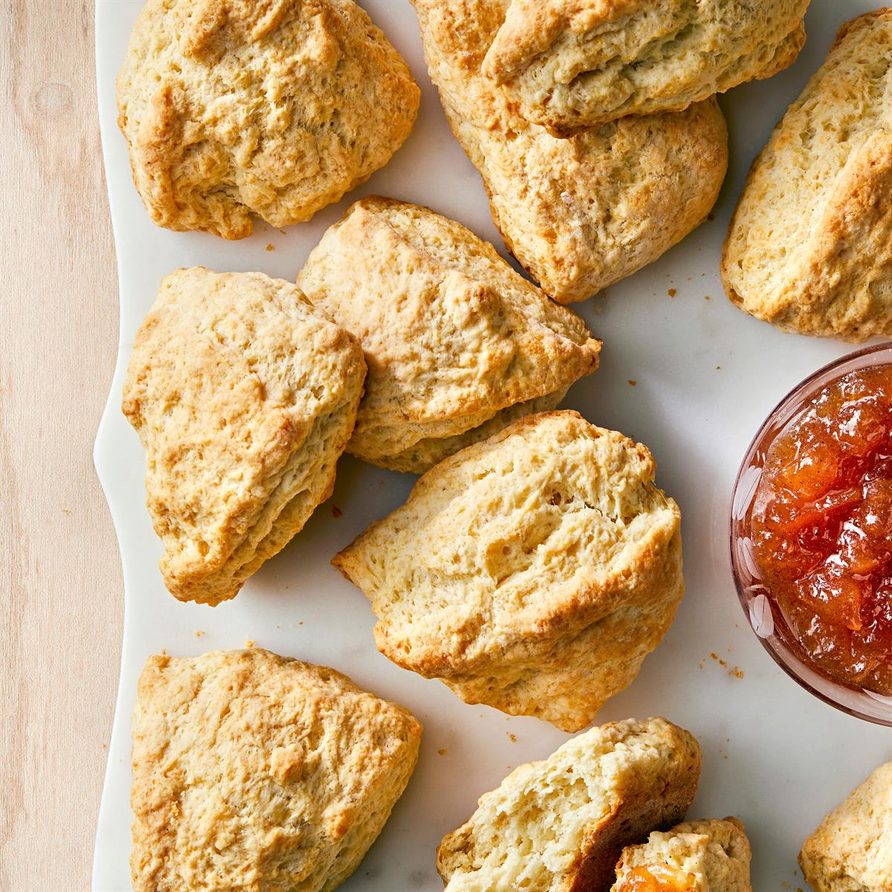This traditional English scones recipe bakes tall, tender scones that have a golden, crispy edge. They’re barely sweet—just as they should be—and the perfect blank canvas for any mix-ins you’re craving.

Scones

Hosting an afternoon tea? Or just in the mood to delight in a flaky, buttery pastry? Whatever the reason, this scones recipe creates the perfect batch of traditional English scones, each with a tender center, a tall stature and crispy, golden edges. All that’s needed is your favorite jam slathered on top.
For those who are feeling a bit more curious, this recipe doubles as a choose-your-own-adventure basic scone recipe. Think of it as a blank canvas to include whatever mix-ins—sweet or savory—you’re craving. There are so many great scone recipes born from creativity in the kitchen, so don’t be shy with your ideas! Check out our detailed Scone Variations section below for inspo.
What is a scone?
A scone is a British baked good that’s enjoyed throughout the United Kingdom and Ireland. They’re typically eaten with clotted cream and jam alongside a cup of tea. Since they’re topped with extras upon serving, an English scones recipe doesn’t typically contain loads of butter or sugar, keeping the actual scones fairly light and flaky. American scone recipes, on the other hand, are filled with much more butter and sugar than traditional English scone recipes, making them denser, heavier, sweeter and gorgeously buttery.
Ingredients for Scones
- All-purpose flour: Scones are supposed to be tall and crispy on the outside with a soft, bread-y center. That’s why we use all-purpose flour to achieve this signature texture. With its mix of hard and soft wheat, all-purpose flour gives the best of both worlds by creating a strong structure for the dough but maintaining a pillowy, tender center.
- Sugar: These scones are lightly sweetened using 2 tablespoons granulated sugar. That way, you can sweeten the scones recipe further with sweet mix-ins or take the scones on a savory route if desired. But there is just enough sweetness and flavor to make the scones taste delicious all by themselves. The sugar also aids in browning, so the scones can get a beautiful bronze hue.
- Leavening agents: This scone recipe contains both baking powder and baking soda for a tall rise and a soft, fluffy center.
- Butter: Use this scone recipe as an excuse to purchase the best butter from the store. Butter is one of the most prominent flavors here, so it must taste its best. The trick to light, flaky scones is cutting super cold butter into the scone dough. I recommend cubing the butter before prepping any other ingredients, then stashing it in the freezer until you’re ready to use it.
- Egg: One egg perfectly binds all the ingredients together.
- Buttermilk: Do your absolute best not to swap another type of cream or milk for the buttermilk. Buttermilk’s acid kickstarts the leavening agents for a taller scone, plus it tenderizes and softens the insides of the scones while creating a slightly tangy flavor.
- Jam: The flavor of the jam is completely up to you. Make your favorite jam recipe or buy a high-quality jam from the store.
Directions
Step 1: Cut the butter into the crumb mixture

Preheat the oven to 350°F. In a large bowl, whisk together the all-purpose flour, sugar, baking powder and baking soda.

Cut in the butter until the mixture resembles coarse crumbs.
Editor’s Tip: You can use a fork or pastry cutter to cut in the butter, but I always love just using my clean hands for better control.
Step 2: Add in the buttermilk mixture

In a small bowl, whisk together the egg and buttermilk until blended.

Add the buttermilk mixture to the crumb mixture just until moistened.
Step 3: Knead and portion the dough

Turn the scone dough onto a lightly floured surface, and gently knead the dough only 10 times.
Editor’s Tip: When bread doughs use baking powder or baking soda, they can’t handle a lot of kneading as yeast doughs can or else they’ll turn out very tough. Be sure to count to 10 when kneading and then promptly stop. The dough will not be perfectly smooth. For those of you who’ve baked Irish soda bread before, you know what I’m talking about!

Divide the dough in half, and pat each portion into a 5-inch circle. Cut each circle into six wedges.
Step 4: Bake the scones

Separate the wedges and place them 1 inch apart on an ungreased baking sheet. Bake the scones until they’re golden brown, 25 to 30 minutes.
Editor’s Tip: For extra browning, brush buttermilk or heavy cream on top of each scone before baking. You could also sprinkle turbinado sugar on top to add a coarse, sugary texture that glistens and gleams after baking.
Step 5: Serve with jam
Serve the scones while they’re still warm. Top with your favorite jam if desired.

Scone Variations
- Add oats or oat flour: Love a little texture? Using oats or oat flour gives your scones a nice chew and earthy flavor. Interested? Check out our blueberry-filled rustic oatmeal scones or these sweet-yet-tart cherry-chip oat scones.
- Brighten with citrus: Citrus zest is a great ingredient to flavor a scones recipe. Use citrus as a subtle flavor component, as in these lemon blueberry scones, or make it the whole shebang, as in these contest-winning triple citrus scones.
- Include fresh or dried fruit: One of the most popular scone recipe inclusions is fruit, whether it’s fresh or dried. Fresh blueberries are beloved in scones, as are rhubarb, strawberries, blackberries, raspberries, apples, pears and peaches. Raisins are traditional in English scones, and cranberries, dried cherries and dried blueberries work too.
- Go nuts with mix-ins: Hunks of milk, dark or white chocolate, or flavored baking chips, are perfect scone inclusions. Beautifully toasted nuts make great mix-ins for scones too. Combine the two and you’ll have a texturally dynamic, flavor-packed scone. Don’t just take our word for it: These hazelnut chocolate chip scones speak for themselves.
- Flavor them for the seasons: When the seasons turn, I can’t help but lean into the flavors that come with them. Bake pumpkin scones in the fall and gingerbread scones during the holidays.
- Make them savory: Since this scones recipe is neutrally flavored, it’s just as easy to change it to a savory recipe as a sweet one. For savory scones, sprinkle shredded cheese, herbs, spices or bacon pieces in the dough. These ham and cheese scones are the perfect example.
- Finish with a glaze: Top sweet scones with a quick vanilla glaze, or drizzle Nutella, dulce de leche or a homemade salted caramel sauce on top after they’re baked.
How to Store Scones
Once your scones are cooled to room temperature, place them in an airtight container. They can be kept out at room temperature for up to three days, or in the fridge for five.
Can you freeze scones?
Yes, you can freeze baked or unbaked scones. To freeze baked scones, allow them to cool to room temperature, then close them in a resealable bag. They can be frozen for up to one week.
To freeze unbaked scones, place the portioned scone wedges on a baking sheet and freeze them for an hour. Transfer the almost-frozen scones to a resealable bag or airtight container. When you’re ready to bake them, simply bake from frozen and add a few more minutes of baking time.
Can you make scones ahead of time?
Absolutely! Actually, one of our favorite tips for hosting an afternoon tea party is to make the scone recipe in advance. Once the scones are baked and cooled to room temperature, carefully place them in a resealable bag and zip it closed. Stash the scones in the freezer for up to a week, then reheat the scones on a baking tray in a 350° oven for 10 minutes.
Scone Tips

Can you substitute something else for the buttermilk?
If you can help it, try your absolute best not to substitute for the buttermilk. It’s a very important ingredient for achieving the best scone texture. If you absolutely must use a buttermilk substitute, a milk and acid mixture is your best bet. To substitute for each cup of buttermilk, use 1 tablespoon white vinegar or lemon juice plus enough milk to measure 1 cup. Stir, then let the mixture stand for five minutes before using.
You could also do a mixture of 1-3/4 teaspoon cream of tartar plus 1 cup milk. Or, simply use 1 cup plain yogurt.
How do you eat scones?
Afternoon British tea etiquette has a few rules, one of them being the proper way to eat a scone. (By the way, afternoon tea scones are always round, so use a round cutter to portion the dough.)
First, make sure the scones are served warm, with small bowls of English cream and some type of jam alongside tiny spoons. Break your round scone in half either vertically or horizontally using your hands or a knife. Break each half in half again so your scone is in quarters. Spoon just enough cream and jam onto your plate (and not directly onto the scone). Using your knife, slather the cream and jam on each piece, and eat each piece in one to two bites.
If you’re at a more casual gathering, enjoy your scone however you please. We still recommend serving it with the cream and jam, though, but only because it’s absolutely delicious!
Watch How to Make Scones
Scones
Ingredients
- 2 cups all-purpose flour
- 2 tablespoons sugar
- 3 teaspoons baking powder
- 1/8 teaspoon baking soda
- 6 tablespoons cold butter, cubed
- 1 large egg
- 1/2 cup buttermilk
- Jam of your choice, optional
Directions
- Preheat oven to 350°. In a large bowl, combine flour, sugar, baking powder and baking soda. Cut in butter until mixture resembles coarse crumbs. In a small bowl, whisk egg and buttermilk until blended; add to crumb mixture just until moistened.
- Turn dough onto a lightly floured surface; gently knead 10 times. Divide dough in half; pat each portion into a 5-in. circle. Cut each circle into 6 wedges.
- Separate wedges and place 1 in. apart on an ungreased baking sheet. Bake until golden brown, 25-30 minutes. Serve warm, with jam if desired.
Nutrition Facts
1 scone: 144 calories, 6g fat (4g saturated fat), 33mg cholesterol, 170mg sodium, 19g carbohydrate (3g sugars, 1g fiber), 3g protein.

















